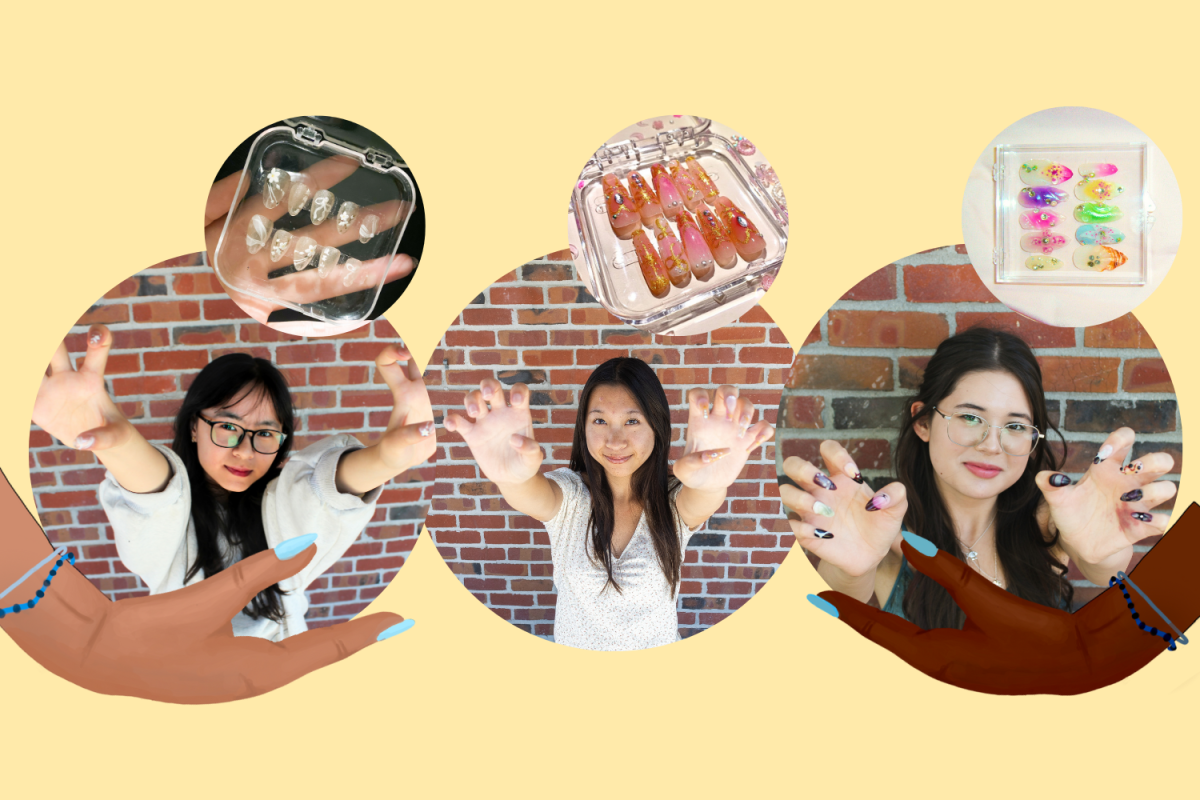Flexing the issue: Male body image
Graphic illustration by Calvin Zhou
The stringent body culture can promote harmful bulking and dieting and exercise practices to impressionable teenage boys.
November 7, 2022
“When he’s skinny, scrawny and looks like he hasn’t eaten in days.” “When he looks like a Greek God statue.” Similar detrimental statements fill social media feeds, perpetuating an unhealthy ideal of what a male body should look like. Whether promising the physique of a bodybuilder through a specific workout regimen or romanticizing severely underweight statures, this stringent body culture can promote harmful bulking and dieting and exercise practices to impressionable teenage boys.
A man’s “ideal body” has shifted dramatically throughout the past century. During the “Gilded Age” — late 1800s to the early 1900s — having a wider waist indicated a higher economic status, as a heavier weight was proof of one’s ability to afford an abundance of food. From the 1920s until the late 1950s, the “Golden Age” shifted the standard from being overweight to lean and athletic. This was a result of Hollywood actors often being required to be toned for their roles, heroizing muscular figures. By the mid 1960s, the perception of a perfect body changed to thin and slender, influenced by popular icons such as The Beatles, David Bowie and Jimi Hendrix, all known for having androgynous appearances. This ideal once again drastically shifted by the late 20th century, when bodybuilding grew in popularity. Brad Pitt in the film “Fight Club” epitomized the desired look: sinewy back muscles and a bulky body. In the current day, a new standard has been set: the “superhero” build of toned muscles, abs and low fat.
During the last 25 years, male body dissatisfaction has increased from 15% to 45%. A 2013 study described that 95% of college-age men are dissatisfied with their bodies on a certain level. Society’s perception of what a male’s body should look like can be dangerous and unrealistic.
“Social media has caused us, as a society, to focus more on appearance than the whole person,” said Dr. Thomas Ellis, embedded psychologist for the Graduate School of Business at Stanford. “Now, your value is based on how you look or what you own versus character or virtues.”
The idolization of athletes sets a standard for males to be physical and sporty. Hollywood and entertainment media feature specific body types of superheroes and protagonists, shedding a positive light on a muscular body and a negative light on others. For example, protagonist Batman is portrayed muscular and strong, while villains such as Penguin are overweight and rotund.
“Our media tends to glorify male celebrities that have a hyper muscular physique as role models, such as Dwayne Johnson or Chris Hemsworth,” said Henry Zhu, Senior Associate of Strategic Partnerships at The Jed Foundation and mental health advocate. JED is a nonprofit which develops teen social-emotional skills and helps suicide prevention. “The Western masculine body ideal is influenced by our emphasis on sports, jock culture and general perception in schools that those who are athletic are higher in social status.”
The stigma surrounding body image has significant and widespread consequences: a survey from the National Eating Disorders Association found that around 30% of teenage boys employ unhealthy weight control practices, including fasting, purging, laxatives and over-exercise. Repercussions aren’t just physical but psychological as well. Male body dissatisfaction has been linked to greater rates of depression as well as anxiety and low self-esteem. Organizations like the National Eating Disorders Association and the GoodTherapy combat these effects by acting as treatment providers to connect individuals with licensed practitioners. FUHSD also offers mental health and wellbeing services in the form of Care Solace.
Men within the LGBTQ+ community are often disproportionately affected by body stigma. A study from the University of Hawaii at Manoa found that 58% of gay men routinely thought about their appearance as compared to 39% of straight men. The study also reported gay men feeling more often objectified or judged. Another study found a similar result among transgender participants: transgender men were more concerned with body image than cisgender men.
“I see a majority of my gay male clients concerned with their body and going to the gym,” Ellis said. “Given the stigma against gay men — that they aren’t real men; that they are feminine or sickly (due to the history of HIV/AIDS) — there’s a push for health and fitness and an overcompensation to be masculine.”
Today’s media culture of advertisements and subliminal messages exploits body image as a marketing tactic. A report from the Advertising Association surveyed over 1,000 boys and found that 41% believe the media portrayal of men is unrealistic.
The classic bronze skin and six-pack models in commercials advertise their view of the epitome of manhood: the V-shaped mesomorph. Sexualization and nudity are also used to garner greater engagement. Although the visual media is often digitally retouched to emphasize physique, there are many who are unaware of the alterations and believe the models to be portrayed as realistic. A U.K.-based study conducted by BBD Perfect Storm found that 78% of surveyed men didn’t know anyone whose appearance was that of a “typical Gillette model” — lean body and chiseled jaw.
“On social media, I see a lot of posts promoting the idea that all men should be 6 feet tall and have a lot of muscles,” junior Shaumik Kalwit said. “I don’t agree with these standards — I think all that matters is that you are healthy and taking care of yourself.”
Social media also plays a large role in furthering unhealthy expectations. Images of toned abdominals, burly biceps and broad shoulders seem to fill the feeds of social media platforms when browsing about fitness. The elusive promise that these same results can be achieved through a specific workout regimen funnels views and online engagement toward similar posts. Through social media, men are increasingly shown shaped as action figures, with small waists and large chests and muscles.
“Fitness being promoted on social media can push for a healthier lifestyle, but there’s also a fine line between working toward a ‘better’ body and using unhealthy ways to get that body,” senior Yechan Lee said.
The model body has been circulated throughout social media and ingrained as an implicit means of publicity, even for those who create content unrelated to fitness. One study involving 1,000 Instagram posts found that posts with men who appeared more lean or muscular received greater audience engagement of likes and comments. Another study of 600 Instagram images by Marika Tiggemann and Mia Zaccardo found that 60% of posts by men displayed high muscularity, implying a platform bias for more conventionally attractive body types.
“A lot of guys post progress checks of their body,” senior Alvin Sun said. “If the person isn’t fairly built, they don’t always get positive reactions. It seems to be the norm that you must be really muscular for it to be ‘acceptable’ to post your body on social media.”
This bias can lead to detrimental dieting and exercise practices, especially among teenage boys. Researchers from Flinders University, Australia discovered that social media use was linked to eating disorders and body dissatisfaction regardless of gender, and other studies have shown that viewing posts of ideal body images made college male students feel worse about themselves.
“There’s this thinking of ‘Well, if I’m not thin and lean and look like a model, then I’m not valuable or attractive or I’m not a viable partner,’” Ellis said. “That mindset can cause depression, social anxiety and narcissism; in social media, you’ll see men who post hundreds of shirtless selfies or focus on their bodies. If they gained that body through steroids or other unhealthy means, then it becomes a self-fulfilling prophecy where the social media attention positively reinforces the negative behavior.”
However, social media does have its silver linings. A growing movement for body neutrality — accepting one’s body for what it does rather than how it looks — and body positivity has pushed back on appearance-centric cyberspaces.
“Although a lot of toxicity does exist on social media, encouraging posts and fitness inspiration are also a source of motivation for many people,” junior Rishab Motgi said.
In fact, experiments illustrate that regarding the body through the lens of function-over-form reduces the stigma of weight. Aside from limiting social media use, healthcare consultants encourage healthy masculinity through cognitive behavioral therapy and mindfulness practices.
“We must also normalize that it is OK to seek professional support for males who may be struggling with their body image and equip their support systems with the know-how for how to initiate these conversations, referring them to care when necessary,” Zhu said.
The first step to shedding a dysmorphic body image is acknowledging the issue. In order to overcome the cultural expectations of the perfect male body, it is important to not view the body as graduations of beauty standards but rather respect it and its importance in daily functions.
“It takes a lot of time,” Ellis said. “Change doesn’t happen overnight. But the start to helping someone with body dysmorphia is helping them gain awareness of how they are a whole person and their value is not completely based upon their appearance.”






























































